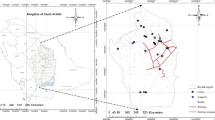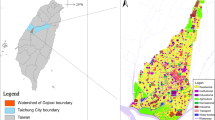Abstract
In dry and semi-dry areas, the damages incurred to the cities and villages could be decreased by guiding and distributing the flood flows. The guidance canals and flood transfer are the most important tools to achieve this goal. This paper aims to predict the routes and guidance canals of the floods to the dust source of Khuzestan province (at the southwestern of Iran). Based on the flood peak points, area’s topography, protected areas, soil texture, and human barriers, 9 guidance canals are presented to transfer the floods to the dust sources. Then, the proposed routes are prioritized using indicators of executive operational cost (cost), the feasibility of flood distribution in the target dust source, the importance degree of the target dust source, flooding risk of sensitive areas, environmental indicator as well as the importance degree of the protected areas against flood in the analytic hierarchy process (AHP). Based on the final ranking, the first executive priority is option 4, which is dredging and recovering the capacity of Maleh and Bahreh; these are considered as the recovery options and must be implemented in the Great Karun basin. The results indicated that the identification and prioritization of flood diversion options can mitigate the adverse effects of both flood and dust hazards in Khuzestan Province, something which can also be implemented in other similar regions.



Similar content being viewed by others
Data availability
Data will be made available on request.
References
Abbaszadeh M, Mahdavi R, Rezai M (2019) Assessment of sedimentation process in flood water spreading system using IRS (P5) and supervised classification algorithms (case study: Dahandar plain, Minab city, south of Iran). Remote Sensing Applications: Society and Environment 16:100269
Arasteh PD (2005) Water Spreading Water Encyclopedia 3:708–712
Cui B, Wang C, Tao W, You Z (2009) River channel network design for drought and flood control: a case study of Xiaoqinghe River basin, Jinan City. China Journal of Environmental Management 90(11):3675–3686
Danumah JH, Odai SN, Saley BM, Szarzynski J, Thiel M, Kwaku A, Akpa LY (2016) Flood risk assessment and mapping in Abidjan district using multi-criteria analysis (AHP) model and geoinformation techniques, (cote d’ivoire). Geoenvironmental Disasters 3(1):1–13
Dargahian F, Razavi Zadeh S, Asl LN, S. (2018) The role of water resources management as one of the factors contributing in the dust resource activity amplification in southern and southeast parts of Ahwaz. Iran Nature 3(4):26–33
Das S, Gupta A (2021) Multi-criteria decision based geospatial mapping of flood susceptibility and temporal hydro-geomorphic changes in the Subarnarekha basin. India. Geoscience Frontiers 12(5):101206
Ding Y, Wang SS (2012) Optimal control of flood water with sediment transport in alluvial channel. Sep Purif Technol 84:85–94
Farahmand H, Dong S, Mostafavi A (2021) Network analysis and characterization of vulnerability in flood control infrastructure for system-level risk reduction. Computers, Environment and Urban Systems 89:101663
Farokheh, S .2016. An analysis of environmental consequences due to entering dust to west of Iran (case study: Sardasht city), Master Thesis in Geography and Urban Planning, majoring in Urban Environment, Mohaghegh Ardabili University.
Feng F, Xu S, Liu J, Liu D, Wu B (2010) Comprehensive benefit of flood resources utilization through dynamic successive fuzzy evaluation model: a case study. SCIENCE CHINA Technol Sci 53(2):529–538
Greco SE, Larsen EW (2014) Ecological design of multifunctional open channels for flood control and conservation planning. Landsc Urban Plan 131:14–26
Hadipour V, Vafaie F, Kerle N (2020) An indicator-based approach to assess social vulnerability of coastal areas to sea-level rise and flooding: a case study of Bandar Abbas city. Iran. Ocean & coastal management 188:105077
Hamidi M (2020) The key role of water resources management in the Middle East dust events. Catena 187:104337
Hermida L, Merino A, Sánchez JL, Fernández-González S, García-Ortega E, López L (2018) Characterization of synoptic patterns causing dust outbreaks that affect the Arabian Peninsula. Atmos Res 199:29–39
Khan A, Govil H, Khan HH, Thakur PK, Yunus AP, Pani P (2021) Channel responses to flooding of Ganga River, Bihar India, 2019 using SAR and optical remote sensing. Adv Space Res
Kittipongvises S, Phetrak A, Rattanapun P, Brundiers K, Buizer JL, Melnick R (2020) AHP-GIS analysis for flood hazard assessment of the communities nearby the world heritage site on Ayutthaya Island, Thailand. International Journal of Disaster Risk Reduction 48:101612
Lin K, Chen H, Xu CY, Yan P, Lan T, Liu Z, Dong C (2020) Assessment of flash flood risk based on improved analytic hierarchy process method and integrated maximum likelihood clustering algorithm. Journal of Hydrology 584:124696
Marchiori L, Schumacher I (2011) When nature rebels: international migration, climate change, and inequality. J Popul Econ 24(2):569–600
Mcleman R, Gemenne F (2018) Routledge handbook of environmental displacement and migration. Routledge, Milton Park, Abingdon. https://doi.org/10.4324/9781315638843-3
Moradi GH, Oprajunghani E (2019) Investigation of the origin of dust and its effects on air pollution, International Conference on Dust in Southwest Asia, May 2019. University of Zabol
Mostafaei A, Kalantari N, Zarkesh MK (2016) Assessing the success of floodwater spreading projects using a fuzzy approach. Water Sci Technol 74(8):1980–1991
Pham BT, Luu C, Van Dao D, Van Phong T, Nguyen HD, Van Le H, ... Prakash I (2021) Flood risk assessment using deep learning integrated with multi-criteria decision analysis. Knowledge-Based Syst 219:106899
Prasetya RB, Fariza A, Hasim JAN, Basuki A (2015) River flood spreading prediction system using cellular automata (Case study Bengawan Solo River). In 2015 International Conference on Data and Software Engineering (ICoDSE) (pp. 201–206). IEEE
Saaty TL (1989) Decision making, scaling, and number crunching, Decision Sciences, VOL 20, Page 404–409
Sissakian V, Al-Ansari N, Knutsson S (2013) Sand and dust storm events in Iraq. J Nat Sci 5(10):1084–1094
Soleimani Z, Teymouri PD, Boloorani A, Mesdaghinia A, Middleton N, Griffin W (2019) An overview of bioaerosol load and health impacts associated with dust storms: a focus on the Middle East. Journal Atmospheric Environment 24(3):533–551
Surian N, Righini M, Lucía A, Nardi L, Amponsah W, Benvenuti M, Viero A (2016) Channel response to extreme floods: insights on controlling factors from six mountain rivers in northern Apennines, Italy. Geomorphology 272:78–91
Tanaka TY, Chiba M (2006) A numerical study of the contributions of dust source regions to the global dust budget. Global Planet Change 52(1):88–104
Zarasvandi A, Carranza EJM, Moore F, Rastmanesh F (2011) Spatio-temporal occurrences and mineralogical–geochemical characteristics of airborne dusts in Khuzestan Province (southwestern Iran). J Geochem Explor 111(3):138–151
Zarkesh MK (2005) Decision support system for floodwater spreading site selection in Iran. ITC
Zeleňáková M, Blistan P, Purcz P (2015) Assessment of flood vulnerability in the Bodva catchment using multicriteria analysis and geographical information systems. River Basin Management 8:51–59
Acknowledgment
We are grateful to the Research Council of Shahid Chamran University of Ahvaz for financial support.
Funding
This study was funded by “Research Council of Shahid Chamran University of Ahvaz.”
Author information
Authors and Affiliations
Corresponding author
Ethics declarations
Ethics approval
Not applicable.
Consent to participate
Consent was obtained from all individual participants included in the study.
Consent for publication
The participant has consented to the submission of the case report to the journal.
Competing interests
The authors declare no competing interests.
Additional information
Responsible editor: Broder J. Merkel
Appendix
Rights and permissions
About this article
Cite this article
Hejazi, S.J. Transferring flood to the dust sources of the province of Khuzestan (Southwest Iran): a multipurpose approach to water resource management. Arab J Geosci 15, 332 (2022). https://doi.org/10.1007/s12517-022-09606-1
Received:
Accepted:
Published:
DOI: https://doi.org/10.1007/s12517-022-09606-1




